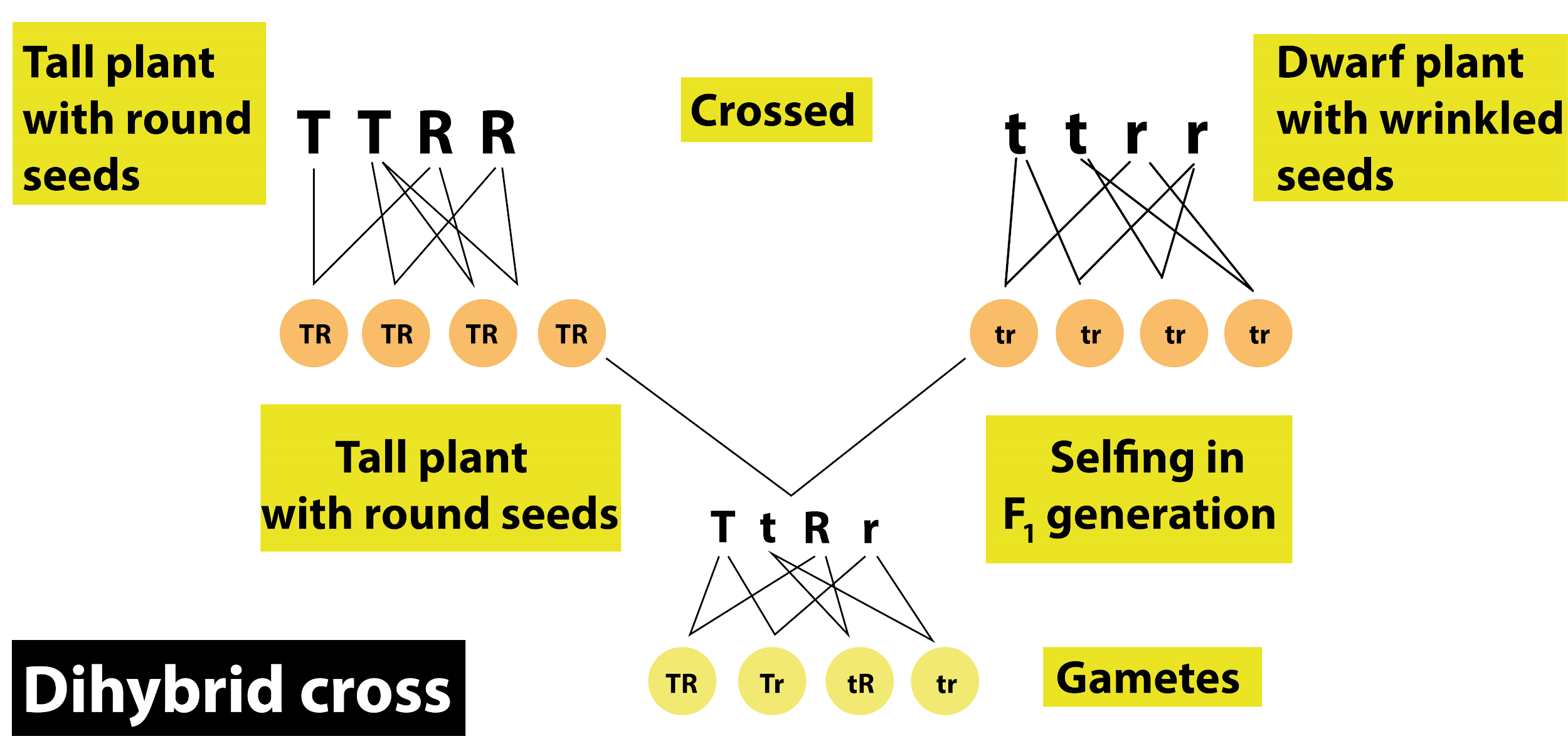
Tall plant with round seeds (TTRR) is crossed with a dwarf plant having wrinkled seeds (ttrr) .
(a) One
(b) Two
(c) Three
(d) Four
Answer
494.4k+ views
Hint: This cross is based on Mendel's Law of Independent Assortment which states that the inheritance of one trait does not affect the inheritance of another. According to his experiment, the number of gametes produced in the
Correct step by step answer:
The Dihybrid cross is a cross between two different genes that differ in two observed traits or a breeding experiment between two organisms which are identical hybrids for two traits.
When a dihybrid forms a gamete, each gamete receives only one allele for each character. Thus, the assortment of an allele of different characters during gamete formation is independent of their parental combinations which means the characters are inherited independently by the offspring even if they are present together on a single chromosome.

During an experiment when a pure tall plant with round seeds (TTRR) is crossed with a dwarf plant having wrinkled seeds (ttrr) . The gametes formed are TR and tr. In the first
So, the correct answer is, ‘four’.
Note:
- The purpose of a dihybrid cross is to determine if any relationship existed between different allelic pairs.
- The 9:3:3:1 is the classic Mendelian phenotypic ratio for a dihybrid cross in which the alleles of two different genes assort independently into gametes.
- In a monohybrid cross the inheritance of one single trait is studied. The cross between homozygous dominant and homozygous recessive genes for a single trait is also called a reciprocal cross.
Correct step by step answer:
The Dihybrid cross is a cross between two different genes that differ in two observed traits or a breeding experiment between two organisms which are identical hybrids for two traits.
When a dihybrid forms a gamete, each gamete receives only one allele for each character. Thus, the assortment of an allele of different characters during gamete formation is independent of their parental combinations which means the characters are inherited independently by the offspring even if they are present together on a single chromosome.

During an experiment when a pure tall plant with round seeds (TTRR) is crossed with a dwarf plant having wrinkled seeds (ttrr) . The gametes formed are TR and tr. In the first
So, the correct answer is, ‘four’.
Note:
- The purpose of a dihybrid cross is to determine if any relationship existed between different allelic pairs.
- The 9:3:3:1 is the classic Mendelian phenotypic ratio for a dihybrid cross in which the alleles of two different genes assort independently into gametes.
- In a monohybrid cross the inheritance of one single trait is studied. The cross between homozygous dominant and homozygous recessive genes for a single trait is also called a reciprocal cross.
Latest Vedantu courses for you
Grade 11 Science PCM | CBSE | SCHOOL | English
CBSE (2025-26)
School Full course for CBSE students
₹41,848 per year
Recently Updated Pages
Master Class 11 Economics: Engaging Questions & Answers for Success

Master Class 11 Business Studies: Engaging Questions & Answers for Success

Master Class 11 Accountancy: Engaging Questions & Answers for Success

Master Class 11 English: Engaging Questions & Answers for Success

Master Class 11 Computer Science: Engaging Questions & Answers for Success

Master Class 11 Maths: Engaging Questions & Answers for Success

Trending doubts
State and prove Bernoullis theorem class 11 physics CBSE

1 ton equals to A 100 kg B 1000 kg C 10 kg D 10000 class 11 physics CBSE

State the laws of reflection of light

One Metric ton is equal to kg A 10000 B 1000 C 100 class 11 physics CBSE

1 Quintal is equal to a 110 kg b 10 kg c 100kg d 1000 class 11 physics CBSE

Difference Between Prokaryotic Cells and Eukaryotic Cells




